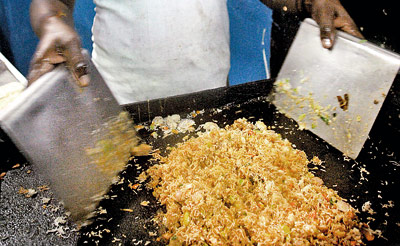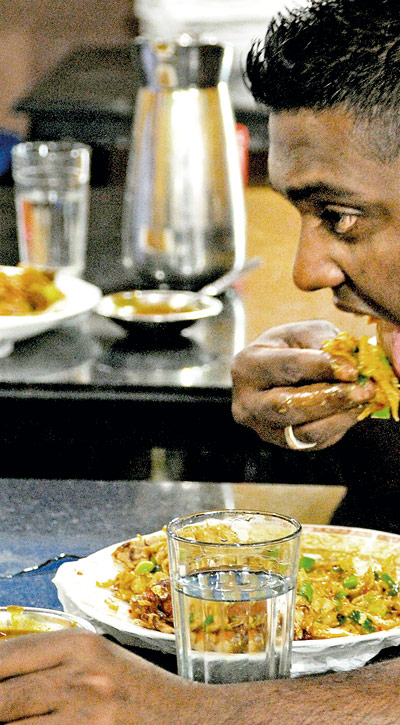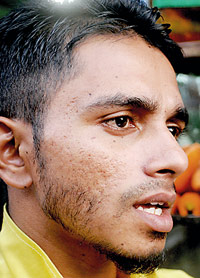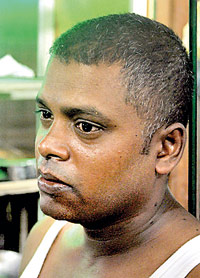News
Everything old is ‘new’ again in killer kottu
Kottu, one of the most popular fast foods, also tops the list of unhygienic meals.
A string of raids by Colombo Municipal Council (CMC) health officials has uncovered evidence that many food outlets prepare kottu with old rotis and curries.
At least 50 restaurants were hauled into court last month alone and similar cases were reported n the outstations.
“If we take into consideration 10 popular food items, kottu will top the list as the most unhygienic,” CMC Chief Medical Officer, Dr. Ruwan Wijeyamuni said.
“One of the reason is that too many people – at least three – are involved in the preparation before it reaches you.
“Chicken, beef or fish left over for several days and even old eggs are used for the kottu along with partially perished vegetables.” As a result, bacteria-infected ingredients become a health hazard.
A tour of some city food outlets showed the conditions in which the popular meal is made.
One cook, clad in a banian and sarong and with sweat pouring down his forehead, was preparing kottu during the rush hour shortly after dusk.

Think before you tuck into a kottu next time. Pix by Amila Gamage
He stretched out his bare hand for a stack of roti already chopped to the required size and some sliced vegetables and broke an egg into it from a container that appeared not to have been cleaned for weeks.
Again with bare hands he added chicken, poured in a variety of sauces and lavishly added monosodium glutamate (MSG).
Above him, insects hovered around two hanging CFL bulbs. Some of them were falling into the meal under preparation as the customer waited for the delivery of a hot kottu at the table.
“We have found that sometimes two to three-week-old roti is used,” said CMC Chief Food Inspector Lal Kumara who has taken part in numerous raids on food outlets.
“When we see this they try to explain away by saying older rotis can be cut easily. This is not correct.”
He said sometimes inspectors found that two to three curries were mixed up together. “You can see the layers of gravy in it,” Mr. Kumara said, adding that the restaurants kept re-using the cooking oil.
The cooks often wore the same clothes for several days and worked with their heads uncovered, the inspector said.
The metal plates used to prepare and cook kottus were sometimes in poor condition and badly cleaned.
In one complaint received by the CMC, a portion broken off one such metal plate, accidentally served up with the kottu, had gashed a customer’s upper palate, causing severe injuries. Action had been filed against the restaurant owner and the outlet was eventually closed down.
Mr. Kumara also warned of health risks in hot kottu being placed directly onto polythene sheets for serving.
Restaurant workers say the claims of bad hygiene are overblown.
“The items required for kottu are prepared a few minutes ahead of cooking. We don’t use old food,” said 28-year-old Mohamed Mihar, making kottu at a hotel in Slave Island.
He said cafes did not make huge profits from kottu roti and if they provided unhygienic meals customers would not return to the shop.
He said some people requested that flavouring such as MSG not be added

Mohamed Mihar: We don’t use old food
to their kottu, and the restaurant adhered to these requests.
Ganapathy Ran, who works at a food outlet in Colombo 2, said that some cooks were compelled to use cheap flavouring, including MSG, in order to keep costs down.
Having worked at other restaurants, preparing kottu, he knew that it was not uncommon to make use of old beef, chicken and fish to prepare the meal.
“Even the manner that the items are stored in refrigerators are not done in a proper manner. Sometimes meat, fish and vegetables are kept together.
Sometimes people who order vegetable kottu are not aware that the vegetables have been kept with the meats,” he added.
Another food outlet owner said that kottu dished out to persons under the influence of liquor was of poor quality as it went unchallenged most times.
| Wider investigation of ‘kottu roti death’ Further investigations have been ordered into the case of an 18-year-old schoolboy who died soon after consuming kottu roti from a food outlet in Elpitiya. The coroner who conducted the inquest into the death of Daham Ayeshan Pathiraja has ordered samples of of stomach contents to be sent to the Government Analyst. On the basis of the report of the Judicial Medical Officer and police evidence, Coroner V.K.P.R. Perera declared the death was due to food poisoning. The boy’s parents said he had died at homein bed last Thursday after consuming the kottu for dinner. Daham’s elder brother had brought him the meal. Daham’s father, Police Sergeant Nihal Pathiraja, 43, said his wife, D.G. Sriya, had tried to wake his son but had found that he had died. Sergeant Pathiraja said that when he had taken his son to the Elpitiya Hospital, doctors had told him that Daham had died after a few hours of sleep. The Uragasmanhandiya police took statements from the father, mother, and one of the dead boy’s two siblings. |

Ganapathy Ran: Some cooks compelled to use cheap flavouring, including MSG, to keep costs down

